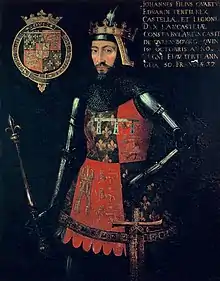Lucas Cornelisz de Kock
Lucas Cornelisz de Kock or Kunst (1495–1552) was a Dutch Renaissance painter active in the Tudor court.[1]

Biography
De Kock was born and died in Leiden. According to Karel van Mander he was a pupil of his father, the painter Cornelis Engelbrechtsz and like his brothers Cornelis and Pieter, was taught to paint by him in Leiden.[2] The little encouragement the art experienced at that time in his native country, obliged him, for the support of a numerous family, to exercise the occupation of a cook, and eventually induced him to visit England.[3] In the time of Henry VIII of England he left for England with his wife and 7 or 8 children, and nothing more was heard of him, though a painting was brought to Leiden by a merchant named Hans de Hartoogh that seemed to be by his hand.[2] He was made painter to the king.[3] Later when the Earl of Leicester became governor and visited the Netherlands with some other Englishmen, they bought up many of his works to take them back to England, where they were sought after.[2]
According to the RKD he was formerly considered to be the same person as Luca d'Olanda, and is known today for historical allegories, drawings, and glass painting.[1]
Van Mander mentions some of the works of this master at Leyden, among others, the 'Adulteress before Christ.' Of his works in England, the sixteen portraits of the Constables of Queenborough Castle, at Penshurst, are the most considerable; and though few of them can be original paintings, they possess great merit. At Hampton Court there are four small female portraits, probably copies, attributed to him.
Today some works of that are considered stylistically similar to works by Jan Wellens de Cock hang in the Museum "Societeit" in Tiel.[1]

 John of Gaunt, Duke of Lancaster
John of Gaunt, Duke of Lancaster
References
- Lucas Cornelisz. genaamd Kunst in the RKD
- (in Dutch) Lucas Cornelisz de Kock in Karel van Mander's Schilder-boeck, 1604, courtesy of the Digital library for Dutch literature
- Bryan 1886
Attribution:
 This article incorporates text from a publication now in the public domain: Bryan, Michael (1886). "CORNELISZ, Lucas". In Graves, Robert Edmund (ed.). Bryan's Dictionary of Painters and Engravers (A–K). Vol. I (3rd ed.). London: George Bell & Sons.
This article incorporates text from a publication now in the public domain: Bryan, Michael (1886). "CORNELISZ, Lucas". In Graves, Robert Edmund (ed.). Bryan's Dictionary of Painters and Engravers (A–K). Vol. I (3rd ed.). London: George Bell & Sons.